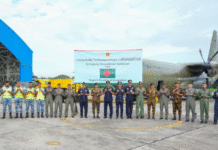Abu Hayat Mahmud
Mobile courts send over 100 beggars to Mirpur beggars’ shelter since October
Beggars in the capital now avoid begging in some ten VIP areas as they fear they will end up in the Sarkari Asroy Kendra, a government-run shelter for vagrants, in Mirpur, a decision taken by the Social Welfare Ministry in February.
The areas include Hazrat Shahjalal International Airport, Radisson Blu Water Garden Hotel, Pan Pacific Sonargaon Hotel, Ruposhi Bangla Hotel, Bailey Road, parliament building, and diplomatic zones in Gulshan, Banani and Baridhara.
A few warning signs which read “No begging zone” have been placed at the spots.
Beggars, who are mostly seen in open spaces, parks, footpaths, in front of shopping centres, footbridges and even in public transports, often cause embarrassment by touching poeple’s hands and legs while asking for money. This is something foreign nationals on Dhaka streets has also faced.
The decision, taken during an inter-ministerial meeting on drives against beggars and their rehabilitation across the country, was part of the government’s initiative to make a beggar-free society and to ensure that beggars do not annoy foreigners on roads. Social Welfare Minister Syed Mohsin Ali chaired the meeting at his office in the Secretariat.
‘Begging is better’
Faridul Mia, a beggar who was begging near Panthakunja Park across Sonargaon Hotel, told the Dhaka Tribune yesterday he no longer begs near the hotel as a policeman told him about the consequences of being there.
“The police official told me I would be detained and sent to the Mirpur shelter,” he said.
The 55-year-old said he makes about Tk5,000-6,000 a month by begging.
“But I will only be provided food at the Mirpur shelter. This is why begging, to my mind, is better,” he added.
Not all beggars, however, despise the life in shelter. Hamida, who was taken to the Mirpur shelter, told the Dhaka Tribune yesterday she had been there for nearly a month.
The 35-year-old said: “I used to beg in Shahbagh but now I am here. I am getting food and receiving sewing training. Compared to the previous times of my life, I feel better. One of my children is also with me.”
Hamida said she was forced to beg as she found herself in a quandary after her husband had divorced her.
A concerted initiative
The beggar-free project is where several authorities are working in conjunction with each other, including the Department of Social Service (DSS) under the Social Welfare Ministry, Dhaka North City Corporation (DNCC), Dhaka South City Corporation (DSCC), and a number of NGOs.
DSCC Social Welfare and Cultural Officer Khandker Millatul Islam told the Dhaka Tribune four mobile teams, led by an executive magistrate each, pay regular visits to the spots where begging has been prohibited.
“Any beggar found in those areas will be sent to the Mirpur shelter,” he said.
DSS Director General Mohammad Saisur Rahman said more than 100 beggars had been sent to the Mirpur shelter since the drive started on October 31, adding that almost 15 child beggars were handed over to their parents.
“The Mirpur shelter can accommodate 200 people. Those who were sent there were taken to the training and rehabilitation centre in Gazipur and other districts a few days later,” he said.
The social welfare minister told the Dhaka Tribune in February those forcing or encouraging poor people to become beggars would be arrested as part of the initiative.
He also said beggars who would face detention would be rehabilitated in their hometowns to help them quit begging.
100,000 beggars in capital
According to the ministry’s data, there are around 100,000 beggars in Dhaka, a city which is home to well over 1.2 crore people. Many of the beggars are physically challenged.
In 2012, a survey was run on 10,000 beggars in the capital to find out the key reasons they had become beggars for and also offer them alternative livelihoods.
The DSS tasked 10 NGOs with carrying out the survey where the beggars were divided into different categories such as seasonal, regular, disabled, women and child.
According to the Bengal Vagrancy Act 1943, the first shelter for beggars was established in Chandpur in August 1947 but it was closed later. In 1961, such shelters were set up in Dhaka, Mymensingh Pubail and Gazipur.
At present, the DSS is running six shelters, two in Gazipur and one in each of the districts – Dhaka, Mymensingh, Narayanganj and Manikganj.
Source: Dhaka Tribune










